Pošip: Croatian White Wine Star
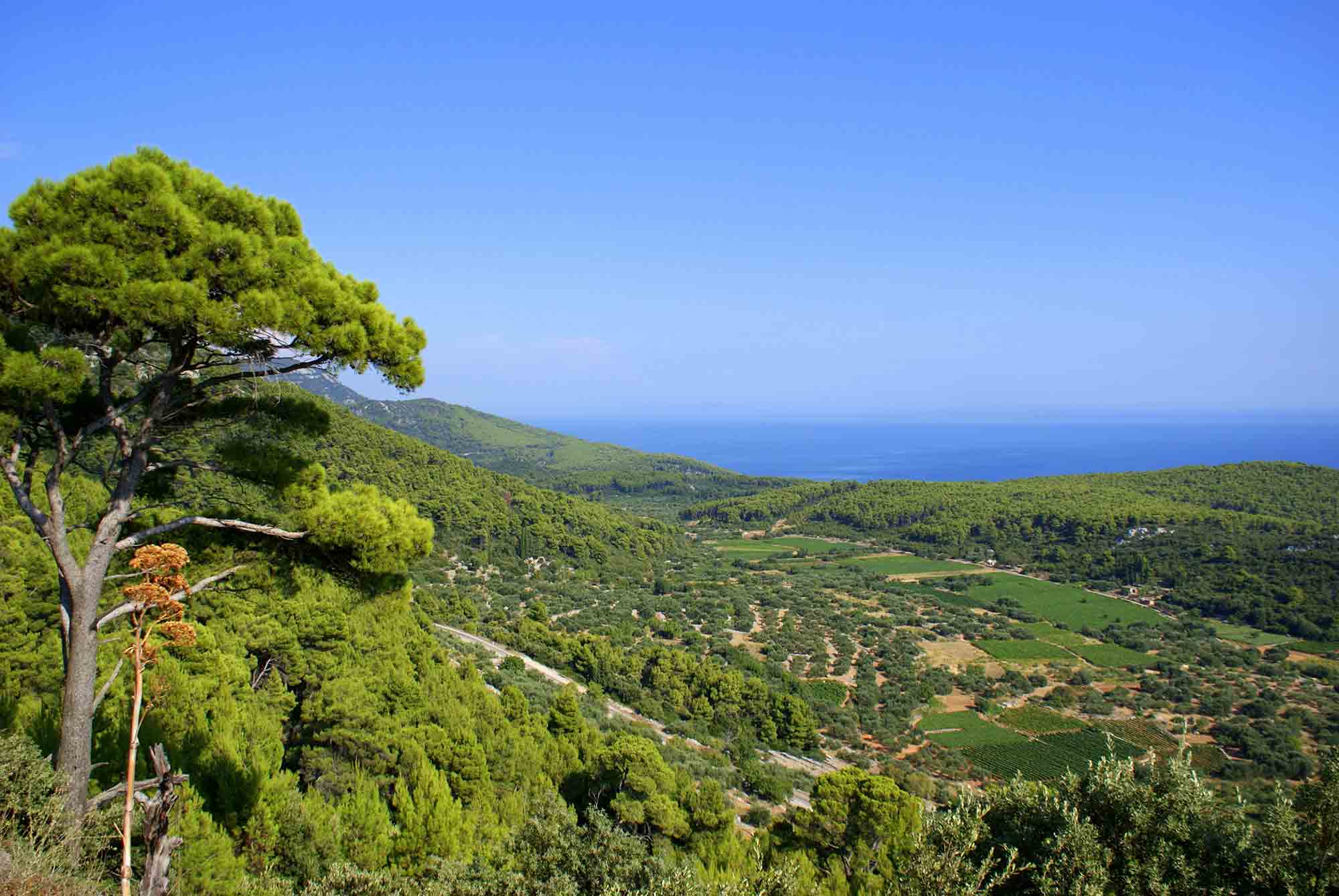
Standing out among 130 Croatian indigenous grape varieties is quite a challenge! That’s what makes Pošip so exciting. It’s probably one of the world’s greatest unknown grape varieties. We’re confident that this variety could easily become your next favorite Croatian white, or even your favorite white overall! Indigenous to Korčula Island and with a fascinating backstory, Pošip wine is undoubtedly the king of Dalmatian whites. Find out why in our article covering everything you need to know about Pošip!
The origin and the history of Pošip wine
In recent years, Pošip (pronounced poe-ship) wines have undergone a significant transformation, becoming highly sought-after Croatian white wine. They serve as a perfect example of how winemaking tradition can be updated without losing its original charms!
Winemakers have been experimenting with new viticulture methods while modernizing winemaking techniques, all while preserving the grape’s unique character and flavor profile.
Pošip’s widespread presence in Dalmatia today proves its remarkable resilience.
But let’s start from the beginning.
The stories behind the origins of grape varieties are often more fascinating than fairy tales.
Just like the story of Zinfandel’s true origins, DNA analysis can either confirm or refute them.
Pošip is one of those wines with a very picturesque origin story, but thanks to DNA analysis, we can consider it authentic.
Dr. Marcel Jelaska from the Institute for Adriatic Cultures, who researched the origin of Pošip, recorded a 19th-century legend in 1967: “Marin Tomašić Barbaca, known as Caparin from Smokvica, while cutting down trees in the Stiniva canyon, found a wild vine in the forest that intrigued him with its excellent taste and unusual aroma.
He cut its branches and planted them in his nearby vineyard in the Punta-Sutvara area.
Over a certain number of years, he multiplied the vines in his vineyard. Also, he gave them to other vine growers from Smokvica and Čara, who also realized its excellent characteristics.”
Back in 2002, professors Maletić and Pejić from the Faculty of Agriculture in Zagreb conducted a molecular marker analysis. They found that Pošip is a descendant of two other unquestionably Korčula indigenous varieties, Bratkovina and Blatska Zlatarica.
Pošip is a rarity among the native grape varieties in the old wine world as it still grows on its original rootstock since it was first planted in the sandy soils of Smokvica village on Korčula Island.
This native white is one of the few that resisted the phylloxera disease which ravaged European and Croatian vineyards at the end of the 19th century.
Smokvica, Čara, and Blato are considered the best places in Korčula where it thrives and produces a diverse range of wines.
A big moment for Pošip was in 1967 when it got recognized with protected geographical origin. It was the first white wine to achieve this after the acclaimed reds of Plavac Mali from Dingač and Postup appellations.
The market expansion of Pošip has coincided with its significant qualitative growth.
Every year, more and more Pošip wines win major international awards, such as Decanter.
Today, it is among one of the most popular Dalmatian wines.
Originally, Pošip grapes were grown almost exclusively on Korčula Island.
It is now produced throughout Dalmatia, in an increasing number of different locations and terroirs.
Besides the islands Vis, Brač, and Hvar, it is planted on Pelješac Peninsula, Komarna, the hinterland of Split, the Šibenik area, vineyards near Nadin and Benkovac, and Konavle near Dubrovnik.
Explore more about grape varieties in the Dalmatian wine region on our Croatian wine map.
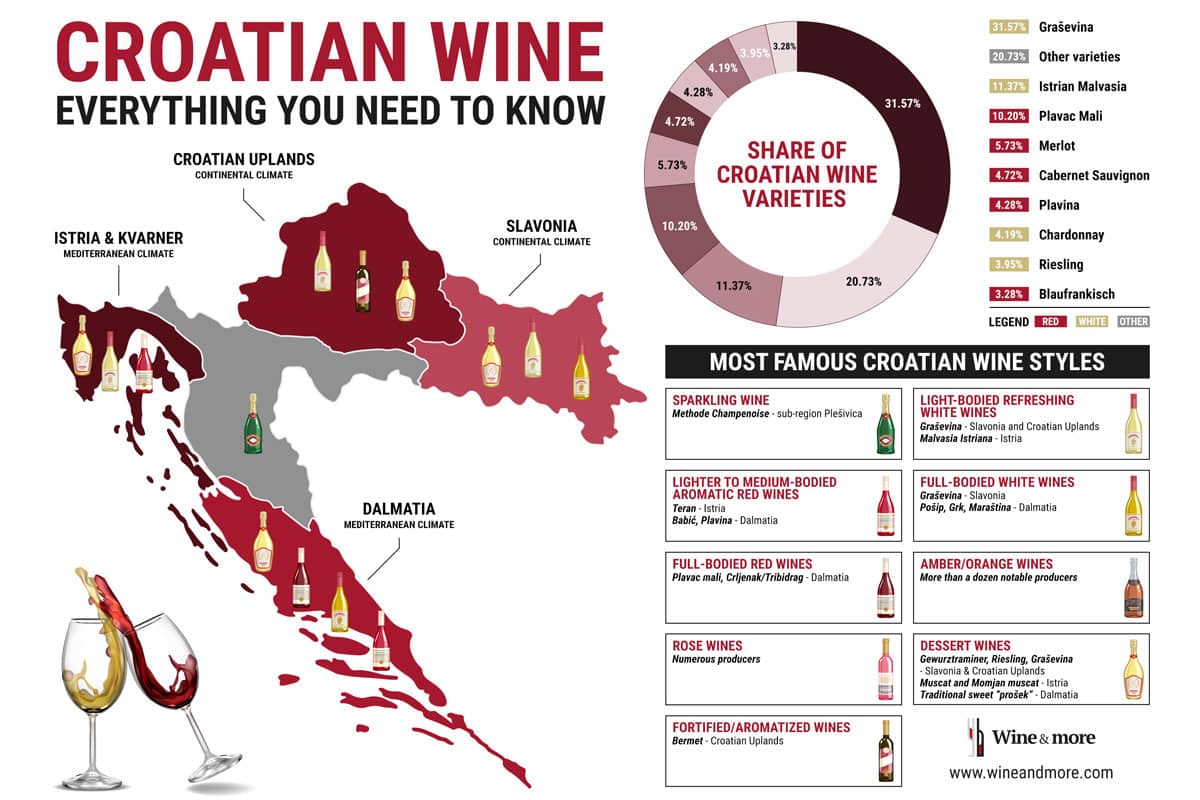
Characteristics of Pošip wine
Pošip is typically made into a dry wine, known for maintaining its acidity and minerality even as sugar levels increase during hot summer days.
Pošip’s taste can vary widely based on where it’s grown and how it’s made.
Modern Pošip wines are often light, refreshing, and fruity, while the traditional style tends to be richer, with higher alcohol content and herbal aromas.
Some Pošip wines are aged in wood or on lees, but many are fermented in stainless steel tanks with controlled temperatures.
Whether aged or not, Pošip has aging potential, though this aspect is yet to be fully explored by dedicated winemakers.
What does Pošip wine taste like?
Pošip wines offer a range of aromas and flavors, influenced by factors such as terroir, winemaking style, and various vinification methods used.
Some, aged in steel, feature intense fruitiness like apricots, peaches, pears, citrus, lime, and passion fruit, bringing forth a delightful combination of juiciness and minerality. Perfectly refreshing summer wine!
Pošip thrives in the Mediterranean climate and yields wines with higher alcohol content and a rich, bigger, and bolder oily texture when aged in wooden barrels. You can find richer notes of dried apricots, figs, spices, and a buttery taste, balanced with a refined acidity in oak-aged Pošips.
Some Pošip wines improve with bottle aging, becoming richer, more flavorful, and better balanced over several years.
Thanks to its quality potential, Pošip stands tall next to so-called “super grapes” such as Chardonnay, Pinots, Rieslings, etc.
Pošip wines can vary stylistically to the point of being unrecognizable. For example, on the market you can find:
- sparkling wines made from Pošip,
- fresh, lively stainless steel Pošips that still retain their southern Mediterranean character,
- fuller-bodied barrel-aged Pošip wines,
- brilliant macerated Pošips,
- desset Prošek wines made from Pošip.
Among the contemporary awarded and prized Pošip wines, it is important to mention those from the Testament and Merga Victa Winery.
Testament produces two different labels of Pošip wines.
One example is the Pošip Testament, cultivated in an organic vineyard in Jadrtovac near Šibenik. Unlike Pošip wines from Korčula, the Pošip grown here tends to be fresher and less aromatic.
In this Pošip, you’ll discover flavors of stone fruit, pear, chamomile flower, and Dalmatian aromatic herbs. It has a complex and mineral flavor, with a fresh and delicious finish. It’s fruit-forward, with a refined quality.
This Pošip was fermented for for three weeks using both wild indigenous and inoculated yeasts, under strict temperature control. It was stirred on lees for two months and aged in stainless steel tanks.
The second one is Pošip Zenit, rich and complex wine, showcasing the typical characteristics of skin-contact fermentation.
It undergoes skin-contact fermentation for 21 days, followed by 6 months of maturation in large, new oak barrels. An additional eight months of maturation in the bottle is followed to ensure optimal integration of the aromas.
Zenit is a Pošip made in the traditional way. It’s a highly aromatic wine, with notes of dried fruits, aromatic herbs, and sweet spices from the oak barrels. The taste is complex, and extremely mineral, but still refreshing.
Merga Victa Winery from the so-called, black island Korčula produces some excellent Pošip wines.
The Dalmatian Dog Pošip is a highly sought-after wine known for its fresh white wine with stone fruit, pronounced citrus aromas, hints of peach, and Mediterranean herbs. It’s dry and medium-bodied.
The grapes are handpicked in the early morning to preserve freshness and aroma, then fermented in stainless steel tanks for three weeks under strict temperature control and further aged on fine lees.
It’s a great introduction to this beloved Dalmatian white wine, providing complexity with a lingering minerality.
Merga Victa Pošip is a light-bodied, crisp white wine. It has a pale yellow color and citrus and green apple aromas. The taste is refreshing, with balanced acidity and a pleasant minerality. On the palate, you’ll find dominant notes of lemon and lime, making it a fruity and harmonious wine.
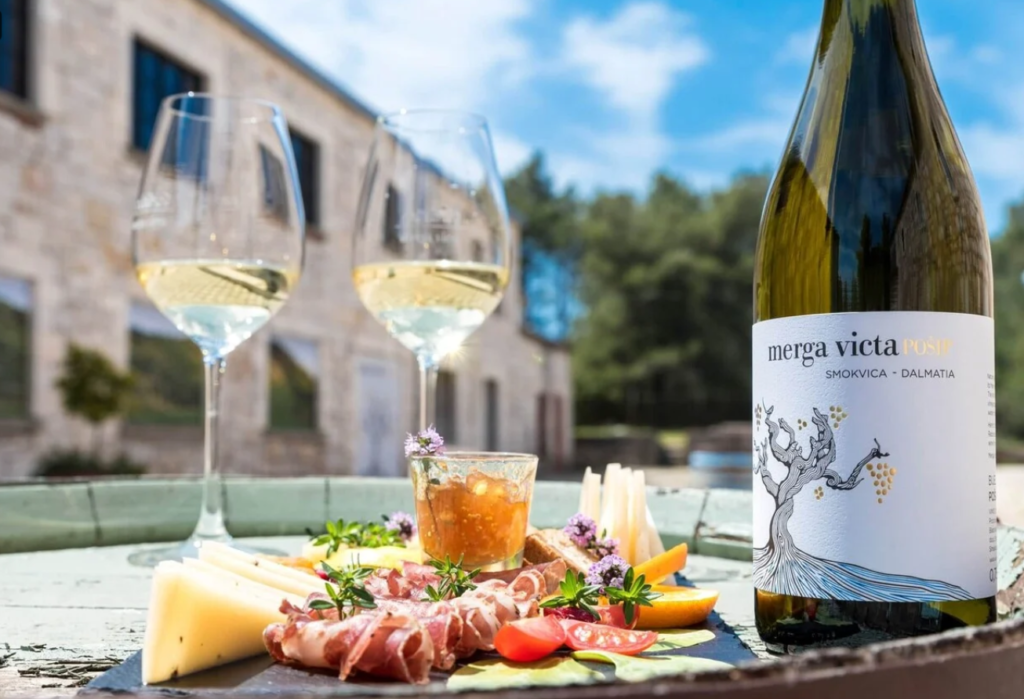
The grapes for Merga Victa are sourced from 25 local family-owned vineyards in Smokvica.
Specifically, grapes for this wine are carefully selected from vineyards aged 15 years or older, located in three different types of soil: red, sandy, and rocky, ensuring a perfect balance in the wine.
The harvest usually takes place at the end of August, during the night, to preserve the grapes’ freshness.
After manual harvesting, the grapes are cooled and undergo further selection in the cellar. They are lightly pressed and fermented for 3-4 weeks at 15°C, then matured for 5 months on fine lees in stainless steel tanks.
Merga Victa Pošip Sur Lie wine displays a rich golden hue and offers pronounced aromas of ripe stone fruits like peach and apricot.
You’ll also catch whiffs of yellow flowers, vanilla, toasted notes, and almonds. On the palate, it’s dry with a long and smooth finish, offering a grapey and yeasty character with subtle hints of wood aging.
This wine benefits from some time in the glass to fully develop its flavors and structure. It’s structured for aging in the bottle.
This full-bodied white wine is crafted from grapes harvested at full maturity and undergoes maceration at low temperatures for 3-8 hours.
Afterward, it matures for 24 months on its lees in 500-liter oak barrels, which are a mix of French, American, and Slavonian oak.
What is Pošip similar to?
At its best, Pošip yields a rich, minerally white with echoes of Southern Rhône varietals.
You’ll find a variety of styles, from juicy and Sauvignon Blanc-like to mineral-rich and Chablis-esque, even to rich, polished examples akin to top-quality wines from the Côte d’Or.
Skilled winemakers even age it in barrels or ferment it Meursault-style.
Food pairing recommendations for Pošip
Today, Pošip wines are balanced and elegant with a specific character reflecting various Dalmatian terroirs. The Dalmatian origins and aroma of Pošip pair best with various Dalmatian dishes.
Young Pošips are excellent as an aperitif and also go well with raw oysters or marinated anchovies or sardines. They are excellent pairing to fish and shellfish dishes and a great choice for pairing with Dalmatian traditional, summer dishes such as gradele (grilled fish, a traditional way of preparing fish).
Aged Pošip wines are great with the finest white fish and shellfish. It also pairs well with creamy dishes such as pan-fried seabass and risotto.
Those macerated and aged on lees (sur lie) in wooden barrels are perfect pairing with fish stew (brodet), steamed clams with fresh herbs, lobster, and shrimps. Or if you have a chance pair it with an octopus cooked under the bell (hobotnica ispod peke).
Pošip is also used to make a dessert wine, making it one of the few varieties whose wines can accompany the entire meal.
Sea bass with pan-fried fennel
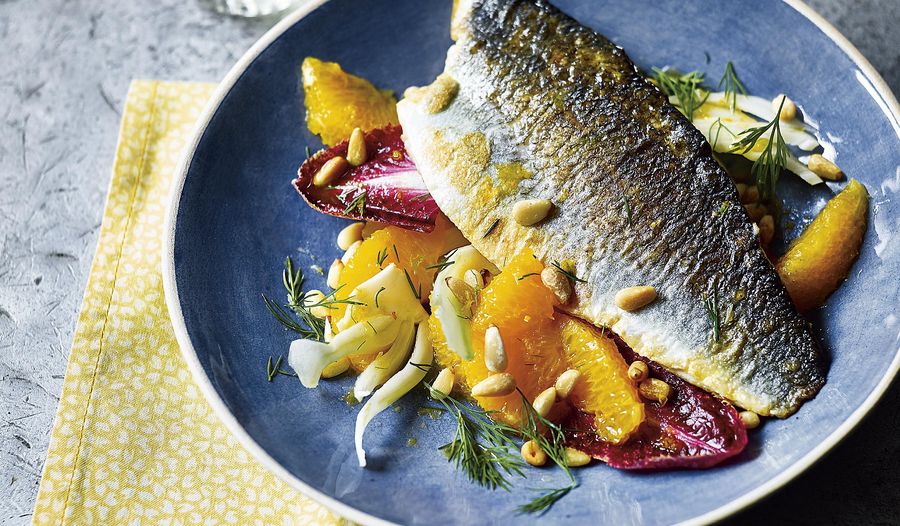
Ingredients:
- 4 small sea bass (each about 250 to 350 g)
- 1 lemon
- 2 sprigs of rosemary
- 50 ml olive oil
- Salt
- Pepper
Side dish:
- 600 g fennel
- 50 ml olive oil
- 2 cloves garlic
- Salt
- Pepper
Instructions:
- Clean, wash, and pat dry the sea bass with paper towels. Season with salt and pepper inside and out. Cut the lemon into thin slices, and halve the rosemary sprigs. Place a few lemon slices and half a sprig of rosemary inside each fish.
- Preheat a grill pan, brush it with olive oil, and fry the fish. During frying, baste the fish with olive oil. Fry for 6-8 minutes on each side.
- In a pan, heat two tablespoons of olive oil and fry the cleaned and chopped fennel until golden brown. Remove from heat, add crushed garlic, remaining olive oil, salt, pepper, and mix well. Cover and let it sit for at least five minutes.
- Serve the grilled sea bass with the fennel side dish.
If you want to enhance the flavor, drizzle the fennel with 50 ml of dry white wine during baking.
Pairing with Testament Zenit Pošip
Testament Zenit Pošip is a great match for this dish. Its refreshing taste, with hints of aromatic herbs and sweet spices from oak barrels, complements the dish beautifully. It pairs especially well with oily fish like sea bass, as the wine’s refreshing qualities balance out the richness of the fish, adding a delightful dimension to the meal.
Pan-fried squid with roasted potatoes and asparagus
Ingredients:
- 1.6-1.8 kg Adriatic squids
- 600 g potatoes
- 500 g green asparagus
- 150 g cherry tomatoes
- 1 lemon
- ½ bunch chives
- 2-3 sprigs of thyme
- 20 g salt
- 100 ml olive oil
- 100 ml sunflower oil
- a pinch of sugar
Instructions:
- Clean the squids. Hold the asparagus in your hand and, starting from the top, use a vegetable peeler to remove the tough cellulose part.
- Blanch the asparagus for 2 – 3 minutes in a little water to which you have added a pinch of salt and sugar. Peel and slice the potatoes. In a hot pan, add 40 ml of olive oil and briefly fry the squids on all sides. In the same pan, along with the squids, fry the cherry tomatoes.
- Season the fried squids with salt. Meanwhile, in another pan, fry the potatoes in sunflower oil and season with salt. Place the asparagus on the bottom of the plate, add the squids and two cherry tomatoes, and place the potatoes on the side. Drizzle the squids with the remaining olive oil, sprinkle with finely chopped chives, add a slice of lemon and a sprig of thyme, garnish with chive stalks, and serve.
Pairing with Testament Pošip
Fried calamari has a crispy, golden outside and a tender inside. To balance out its richness and crunchiness, pair it with a refreshing Pošip wine. Pošip Testament, with its clean and dry profile, complements the delicate flavors of calamari without being too overpowering. This wine typically has notes of apple, pear, chamomile flower,, and Dalmatian karst aromatic herbs, which go well with the briny and slightly sweet taste of calamari and pairs asparagus perfectly.
Grilled octopus with vegetables
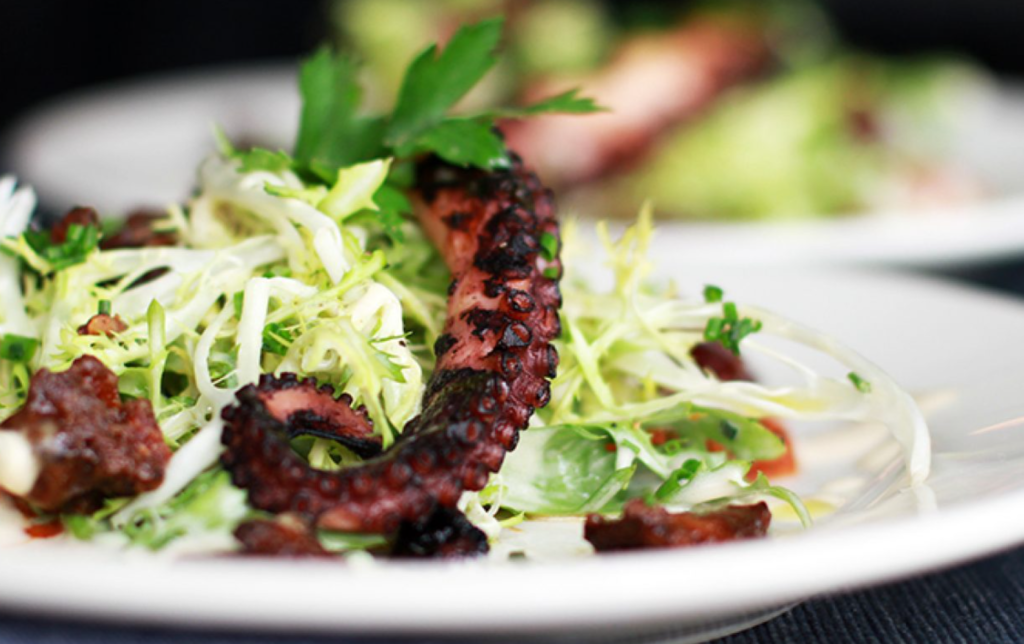
Ingredients:
- 1.8-2 kg octopus
- 500 g asparagus
- 150 g cherry tomatoes
- 300 g potatoes
- 30 g microgreens
- 1 lemon
- Salt
- Sugar
- 80 ml olive oil
- 300 ml frying oil for potatoes
- Mediterranean spice blend
Instructions:
- Clean the octopus, bring water to a boil, and blanch the tentacles in boiling water first to start curling, then place the whole octopus to cook. After 40 minutes of cooking, check the octopus; if it’s not tender, continue cooking until soft. Once cooked, cool the octopus and cut the tentacles.
- Meanwhile, clean the asparagus, removing the tough fibrous part, and blanch them for 2-3 minutes in a pot of water with a pinch of salt and sugar added. Halve the cherry tomatoes.
- Peel and slice the potatoes into waffle-cut slices. Fry the potatoes in deep frying oil, then place them on a paper towel to drain excess oil and season with salt. In a skillet, heat half of the olive oil and grill the octopus tentacles for 2-3 minutes on each side. Add the cherry tomatoes to the skillet and sauté briefly, then add the asparagus.
- Arrange the octopus with tomatoes on the potatoes, add 3-4 asparagus spears, season with Mediterranean spice blend, drizzle with the remaining olive oil, sprinkle with microgreens, and serve with a slice of lemon.
If you want to ensure that the octopus is tender, freeze it before cooking and thaw it when you need to clean and cook it.
Pairing with Merga Victa Pošip
Grilled octopus has a tender texture and delicate, sweet, and salty flavor. Merga Victa Pošip is a wine with nice minerality and sufficient acidity to counterbalance the dish’s richness and flavors that harmonize with the sweet, smoky, and briny elements of the octopus. Its citrusy and herb flavors provide a nice contrast to the smoky flavors of the grilled octopus.
Conclusion
Lucky for every wine enthusiast, our online wine shop offers quite a selection of Pošip wines. With delivery to EU-wide, UK, and US be sure to check Pošip that suits your palate!
Moreover, some of them enjoy cult status among Croatian wine connoisseurs, so you can choose between the very top examples!
Check out our traveling tips if you plan to visit Korčula Island or the Pelješac Peninsula! We covered everything, from food to wine, so that you can book a trip without a drop of worry!
Cheers!



















